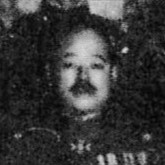
1889 - 1951
Takuma Nishimura
Summary
Name:
Years Active:
1941 - 1945Birth:
September 12, 1889Status:
ExecutedClass:
Mass MurdererVictims:
155+Method:
ShootingDeath:
June 11, 1951Nationality:
Japan
1889 - 1951
Takuma Nishimura
Summary: Mass Murderer
Name:
Takuma NishimuraStatus:
ExecutedVictims:
155+Method:
ShootingNationality:
JapanBirth:
September 12, 1889Death:
June 11, 1951Years Active:
1941 - 1945bio
Takuma Nishimura was born on September 12, 1889, in Fukuoka Prefecture, Japan. He graduated from the Imperial Japanese Army Academy in 1910 and the Army Staff College in 1920. Much of his early military career was spent in staff roles within the Imperial Japanese Army General Staff, a position of prestige in pre-war Japan. He also attended the Army Engineering School, strengthening his logistical and technical credentials within the force.
In 1932, Nishimura presided as judge over the court-martial of Japanese officers involved in the assassination of Prime Minister Inukai Tsuyoshi. The assassins received surprisingly light sentences, which critics argue may have set the tone for increasing militarist impunity in Japan. Following this, Nishimura was appointed commander of the elite Imperial Guard Division, a prestigious post typically reserved for trusted officers.
From 1936 to 1939, he held various field commands, including the 9th Infantry Regiment and the 1st Heavy Field Artillery Brigade. His strategic and leadership roles grew during the late 1930s, and in 1940, he was named Chief of Staff of the Eastern Defense Army, later promoted to Major General.
Nishimura’s career accelerated during Japan’s imperial expansion. He commanded the Indochina Expeditionary Army during the 1940 invasion of French Indochina, and by 1941, he was a Lieutenant General. That same year, he assumed command of the Imperial Guard Division, an elite unit tasked with spearheading Japan’s invasion of British Malaya.
murder story
During World War II, General Nishimura led the Imperial Guard Division in Japan’s swift and brutal conquest of Malaya. His division participated in the Battle of Muar, where they overwhelmed Allied forces. In the aftermath, approximately 155 wounded Australian and Indian prisoners of war were executed by Japanese troops near Parit Sulong. The massacre involved the shooting, burning, and denial of medical aid to prisoners.
After the fall of Singapore in February 1942, Nishimura was placed in charge of eastern Singapore, where the Sook Ching Massacre occurred — a systematic campaign targeting suspected anti-Japanese Chinese civilians. Thousands of civilians were killed across several days. Although the overall massacre involved multiple Japanese commanders, Nishimura’s role as the area’s military governor made him partially responsible.
Conflicts with General Tomoyuki Yamashita, the head of the 25th Army, reportedly strained command coordination. Nishimura’s conduct was so controversial that his division was denied the Emperor’s Victory Citation, and he was forced into retirement in April 1942.
Despite this setback, Nishimura returned to power in 1943 when he was appointed Governor of the Shan States in Burma, followed by military governor of Sumatra in 1944. He held that post until the end of the war.
Following Japan’s surrender in August 1945, Nishimura was tried by a British military tribunal in Singapore for his role in the Sook Ching massacre. He was convicted of war crimes and sentenced to life imprisonment. He served four years in Singapore before being transferred to Japan to complete his sentence.
In a rare second prosecution, Nishimura was removed from a ship in Hong Kong by Australian military police while being repatriated. He was then brought to Manus Island, in the Australian Territory of Papua and New Guinea, where a new tribunal was assembled to try him for the Parit Sulong massacre.
Though one surviving witness, Lieutenant Hackney, could not positively identify Nishimura from a photograph, other evidence was presented showing that he had ordered the execution and destruction of POWs’ bodies. Some modern Japanese sources, including journalist Hiroshi Kato, questioned the photo evidence and suggested that mistaken identity may have occurred. However, additional documents, testimonies, and command orders affirmed Nishimura’s direct involvement.
He was convicted once again by the Australian military tribunal and sentenced to death.
On June 11, 1951, Takuma Nishimura was executed by hanging. The execution was carried out by Australian authorities and marked one of the few instances of a Japanese officer being tried and executed by two Allied nations for separate war crimes.
In 1996, Australian journalist Ian Ward questioned the integrity of the trial, suggesting that the prosecution may have manipulated evidence due to personal biases stemming from wartime trauma. He also referenced a confession by another Japanese officer, Lieutenant Fujita Seizaburo, who reportedly took full responsibility for the Parit Sulong massacre, but Fujita was never charged and later disappeared.
However, in 2007, a detailed study by Professor Gregory Hadley and James Oglethorpe, published in the Journal of Military History, debunked these allegations, showing that claims of evidence manipulation were based on fabricated documents created decades after the trial for political purposes.